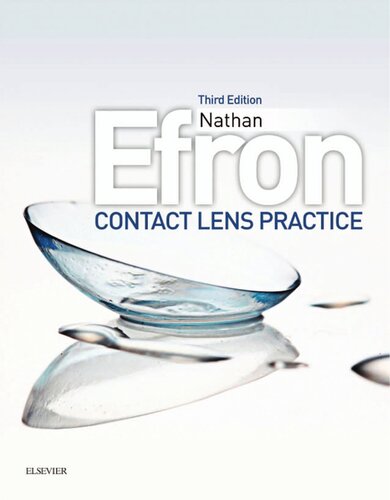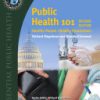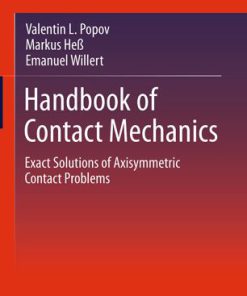CONTACT LENS PRACTICE 3rd Edition by Nathan Efron 0702066627 9780702066627
$50.00 Original price was: $50.00.$25.00Current price is: $25.00.
CONTACT LENS PRACTICE 3rd Edition by Nathan Efron – Ebook PDF Instant Download/DeliveryISBN: 0702066627, 9780702066627
Full download CONTACT LENS PRACTICE 3rd Edition after payment.
Product details:
ISBN-10 : 0702066627
ISBN-13 : 9780702066627
Author: Nathan Efron
The constantly evolving field of contact lens practice provides an ongoing challenge to eye care practitioners and students to keep up to date with latest developments and thinking in the field. In this thoroughly revised and updated third edition of Contact Lens Practice, award-winning author, researcher and lecturer, Professor Nathan Efron, provides a comprehensive, evidence-based overview of the scientific foundation and clinical applications of contact lens fitting. The text has been refreshed by the inclusion of ten new authors – a mixture of scientists and clinicians, all of whom are at the cutting edge of their specialty. The chapters are highly illustrated in full colour and subject matter is presented in a clear and logical format to allow the reader to quickly hone in the desired information.
Highlights of this edition include a new chapter on myopia control contact lenses, as well are completely rewritten chapters, by new authors, on keratoconus, orthokeratology, soft and rigid lens measurement and history taking. A new section on the newly-described condition ‘lid wiper epitheliopathy’ is also presented in an updated chapter on contact lens complications.
Whether you are an optometrist, ophthalmologist, orthoptist, optician, student, or work in the industry – this book will serve as an essential companion and guide to current thinking and practice in the contact lens field.
CONTACT LENS PRACTICE 3rd Table of contents:
Part 1. Introduction
1. History
Introduction
Early Theories (1508–1887)
Glass Scleral Lenses (1888)
Plastic Scleral Lenses (1936)
Plastic Corneal Lenses (1948)
Silicone Elastomer Lenses (1965)
Soft Lenses (1972)
Rigid Gas-permeable Lenses (1974)
Disposable Lenses (1988)
Daily Disposable Lenses (1994)
Silicone Hydrogel Lenses (1998)
Myopia Control Lenses (2010)
Contact Lens ‘Flat Pack’ (2011)
The Future
2. Anterior Eye
Introduction
The Cornea
The Ocular Adnexa
The Preocular Tear Film
Conclusion
3. Visual Optics
Introduction
The Basic Optics of the Eye and Ametropia
Corneal Topography
Pupil Diameter and Retinal Blur Circles
Effects of Diffraction and Aberration
Effectivity, Spectacle Magnification, Accommodation and Convergence Effects with Contact Lens and Spectacle Corrections
Other Optical Effects
Conclusion
Part 2. Soft Contact Lenses
4. Soft Lens Materials
Introduction
Polymers
Properties of Hydrogel Materials
Soft Lens Materials
Classification of Soft Lens Materials
Conclusion
Appendix 4.1. Classification of soft lens materials
5. Soft Lens Manufacture
Introduction
Methods of Manufacture
Reproducibility and Quality of Mass-produced Lenses
Occupational Safety in Lens Manufacture
Conclusion
6. Soft Lens Optics
Introduction
On-eye Power Changes
Aberration
Conclusion
7. Soft Lens Measurement
Introduction
Lens Conditioning According to ISO 18369-3
Optical Parameters
Material Properties
Lens Geometry
Conclusion
8. Soft Lens Design and Fitting
Introduction
Ocular Measurement
Basic Principles
Soft Lens Design
Soft Lens Fitting Options
Trial Lens Fitting
Lens Fit Characteristics
Assessment of Fit
Soft Lens Fitting Problems
Fitting Caucasian versus Oriental eyes
Conclusion
9. Soft Toric Lens Design and Fitting
Introduction
Criteria for Use of Soft Toric Lenses
Design of Soft Toric Lenses
Principles of Correction
Planned Replacement of Soft Toric Lenses
Limitations of Toric Soft Lenses
Conclusion
10. Soft Lens Care Systems
Introduction
Lens Care Systems
Rewetting Solutions
Saline Solutions
Relative Performance Measures
The Lens Storage Case
Conclusion
Part 3. Rigid Contact Lenses
11. Rigid Lens Materials
Introduction
Hybrid Rigid Gas-permeable Materials
The Gaylord Patents – Harnessing Silicon
Commercial Rigid Materials and their Properties
Conclusion
12. Rigid Lens Manufacture
Introduction
Rigid Lens Manufacture
Specialty Rigid Lens Manufacture
Industry Regulation
Conclusion
13. Rigid Lens Optics
Introduction
Basic Tear Lens Properties
The Tear Lens During Trial Lens Fit
Required BVP when the Lens to Be Ordered has a Different BOZR from the Trial Lens Used
Calculation of Required Surface Radii from a Trial Lens Fit
Neutralization of Corneal Astigmatism by a Rigid Lens of Spherical Power
Aberrations of Rigid Contact Lenses
Other Rigid Lens Effects
Conclusion
14. Rigid Lens Measurement
Introduction
Lens Geometry
Optical Properties
Material Properties
Conclusion
15. Rigid Lens Design and Fitting
Introduction
Ocular Topography
Forces Acting on the Rigid Lens
Rigid Lens Design
Trial Fitting Options
Selection of Initial Lenses
Lens Insertion, Removal and Settling
Lens Fit Characteristics
Assessment of Lens Fit
Rigid Lens Fitting Problems
Conclusion
16. Rigid Toric Lens Design and Fitting
Introduction
Forms of Toric Lens
Criteria for Use
Design Considerations
Optical Considerations
Conclusion
17. Rigid Lens Care Systems
Introduction
Disinfection and Wetting Solutions
Cleaning Solutions
Protein Removal Solutions
Disinfection of Trial Lens Sets
Conclusion
Part 4. Lens Replacement Modalities
18. Daily Disposable Soft Lenses
Introduction
Patterns of Wear
Clinical Performance
Advantages from the Perspective of Practitioners
Advantages from the Perspective of Lens Wearers
Disadvantages
Comfort Enhancement Strategies
Manufacturing Reliability
Environmental Impact
Limitations to More General Acceptance
Corneal Infiltrative Events and Keratitis
Lens Application to Assist Ametropes in Eyewear Selection
Conclusion
19. Reusable Soft Lenses
Introduction
Advantages of Planned Replacement
Potential Disadvantages of Planned Replacement
Determining the Appropriate Lens Replacement Frequency
Practice Management Issues Relating to Planned Soft Lens Replacement
Conclusion
20. Planned Replacement Rigid Lenses
Introduction
Life Expectancy of Rigid Contact Lenses
Regular Replacement of Rigid Lenses
Advantages of Regular Replacement of Rigid Lenses
Optimum Replacement Schedule
Planned Replacement Schemes Available
Conclusion
Part 5. Special Lenses and Fitting Considerations
21. Scleral Lenses
Introduction
Advantages and Disadvantages of Scleral Lenses
Indications for Scleral Lenses
Fitting Principles
Modification
Ordering Scleral Lenses
Lens Hygiene and Maintenance
Problems and Complications with Scleral Lens Wear
Future Developments
Conclusion
22. Tinted Lenses
Introduction
Basic Options
Tinted Lens Designs and Applications
Manufacture
Clinical Considerations
Conclusion
23. Presbyopia
Introduction
Patient Selection
Initial Measurements
Pupil Size
Bifocal and Multifocal Contact Lenses
Conclusion
24. Extended Wear
Introduction
Experiences with Extended Wear
Adverse Effects of Extended Wear
Clinical Extended-wear Practice
Application of Extended Wear in Practice
Conclusion
25. Sport
Introduction
Deciding on the Best Form of Correction
Do Contact Lenses Enhance Sporting Performance?
Environmental and Physical Constraints
General Considerations
Conclusion
26. Keratoconus
Introduction
Keratoconus Clinical Assessment
Refractive Management of Keratoconus
Monitoring Keratoconus Progression
Conclusion
27. High Ametropia
Introduction
Lens Materials for High Ametropia
Principles of High-power Lens Design
Fitting Challenges
Low Vision
Conclusion
28. Babies and Children
Introduction
Indications
Elective Contact Lens Wear in Children
Ocular Response to Lens Wear
Examination Techniques
Lens Selection
Handling of Lenses
Common Aftercare Problems
29. Therapeutic Applications
Introduction
Indications
Lens Types
Concurrent Medication
Drug Delivery
Complications
Conclusion
30. Post-refractive Surgery
Introduction
Types of Refractive Surgery
Contact Lens Fitting Following Photorefractive Procedures
Contact Lens Fitting Following Radial Keratotomy
Contact Lens Fitting Following Intrastromal Corneal Ring Segments
Conclusion
31. Post-keratoplasty
Introduction
Indications
Types of Corneal Graft
Irregular Corneal Topography Following KP
Suture Techniques for PKP
Indications and Contraindications for Contact Lens Wear Post-corneal Grafts
General Concerns
Lens-fitting Techniques
Continuing Care and Complications
Graft Rejection and Failure
Other Management Issues
Contact Lens Results
Conclusion
32. Orthokeratology
Introduction
History of Orthokeratology
Modern Orthokeratology
Overnight Orthokeratology
How Orthokeratology Works
Outcomes of Accelerated Orthokeratology
Hyperopic Orthokeratology
Orthokeratology Lens Fitting
Aftercare
Myopia Control with OK
Conclusion
33. Myopia Control
Introduction
Patient Selection and Risk Factors
Types of Contact Lenses
Fitting a Myope with Contact Lenses
Continuing Care and Complications
Conclusion
34. Diabetes
Introduction
The Anterior Eye
Ocular Response to Contact Lenses
Glucose Sensing in the Anterior Eye
Contact Lens Wear in Patients with Other Systemic Disease
Conclusion
Part 6. Patient Examination and Management
35. History Taking
Introduction
Indications and Contraindications for Contact Lens Wear
History-taking Structure
Patient Education, Risk/Benefit Analysis and Informed Consent
Patient Compliance
Conclusion
36. Diagnostic Instruments
Introduction
Observation of the Eye
Measurement of Corneal Sensitivity
Assessment of Anterior-segment Morphology
Determination of Corneal Thickness
Conclusion
37. Preliminary Examination
Introduction
Measurement of Vision
Objective and Subjective Refraction
Anatomical Measurements
Keratometry
Slit-lamp Biomicroscopy
Tear Film Evaluation
Wavefront Refraction
Corneal Topography
Corneal Tomography and Pachymetric Mapping
Ophthalmoscopy
Binocular Vision Assessment
Supplementary Tests
Conclusion
38. Patient Education
Introduction
Creating the Optimum Teaching Environment
Patient Instruction
Informed Consent
Conclusion
39. Aftercare
Introduction
Recommended Visit Schedules
Preparing for the Aftercare Visit
Aftercare Procedures while Lenses are Worn
Aftercare Procedures Following Lens Removal
Discussion with Patient
Grading Scales
General Approaches to Solving Problems
Conclusion
40. Complications
Introduction
Eyelids
Tear Film
Conjunctiva
Limbus
Corneal Epithelium
Corneal Stroma
Corneal Endothelium
Conclusion
41. Digital Imaging
Introduction
Benefits of Digital Imaging for Contact Lens Practice
How much Resolution is Required for Anterior Eye Digital Imaging?
How do I get a Brighter Image?
Commercial Digital Imaging Systems
Digital SLR Camera Slit-lamp Imaging System
Smartphone Digital Imaging
Video Slit-lamp Imaging System
Recording Digital Movies
File Back-up and Printing
Infrared Imaging
OCT Anterior Segment
Scanning Slit-beam Imaging
Confocal Microscopy
Image Editing
Conclusion
42. Compliance
Introduction
Consequences of Non-compliance
Extent and Pattern of Non-compliance
Duration of the Prescription
Erroneous Contact Lens Procedures
Reasons for Non-compliance
Compliance with the Incorrect Prescription
Compliance with the Correct Prescription
Investigation of Strategies for Compliance Enhancement
Predicting Non-compliance
A Compliance Enhancement Model
Conclusion
43. Practice Management
Introduction
Practice Location and Accommodation
Personnel at the Practice
Products and Services Provided
Pricing – Fees and Charges
Promotional Issues
Processes
Professional Regulation
People also search for CONTACT LENS PRACTICE 3rd :
instruments used in contact lens practice
geoff wilson contact lens practice
diploma in contact lens practice
what is over refraction in contact lens practice
nathan efron contact lens practice pdf
Tags: CONTACT LENS, PRACTICE, Nathan Efron, practitioners
You may also like…
History - World History
Politics & Philosophy - Social Sciences
Handbook of Mental Health and Aging 3rd Edition Nathan Hantke (Editor)
Politics & Philosophy - Government & Politics
Education Studies & Teaching
Languages - Spanish Language Reference
Practice Makes Perfect: Complete Spanish Grammar, Premium 3rd Ed 3rd Edition Gilda Nissenberg
Uncategorized
Handbook of Contact Mechanics Exact Solutions of Axisymmetric Contact Problems Valentin L. Popov
Mathematics
Computer Age Statistical Inference Algorithms Evidence and Data Science 1st Edition Bradley Efron
Politics & Philosophy - Social Sciences
Action Research in Education A Practical Guide Sara Efrat Efron













